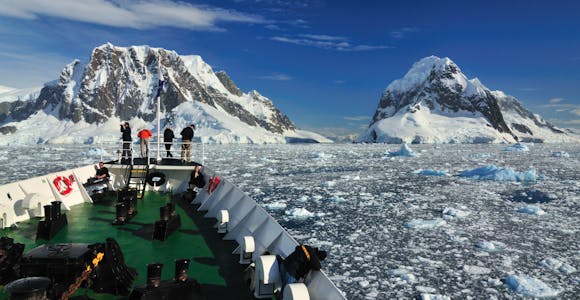
How to get to Antarctica
Whether you’re visiting the Antarctic Peninsula or heading for the South Pole, discover the different routes by sea and air to visit the Seventh Continent.
Discover MorePrice Match Promise-We’ll match any price you find elsewhere for the same trip
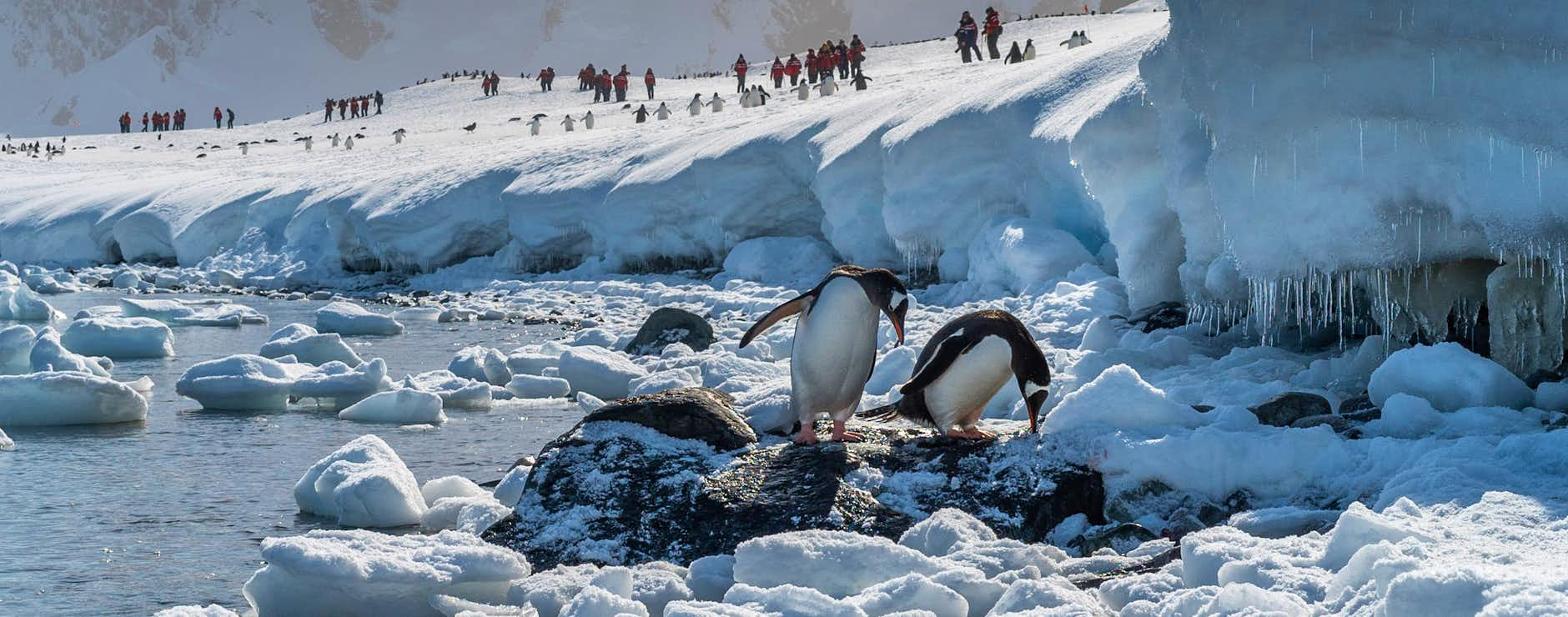
With an abundance of penguins and bays full of spouting whales, the Antarctic Peninsula is truly rich in incredible wildlife. Add in a natural lack of fear of people plus the epic drama of its scenery, and you’ve got one of the greatest wildlife watching destinations on Earth.
When it comes to world-class wildlife watching destinations, Antarctica more holds it own against the African plains or the Galapagos Islands – and beats them hands down when it comes to awe-inspiring scenery.
Few places could ever hope to have their spirit encapsulated so perfectly as Antarctica and its penguins. Endlessly full of personality, they are the true banner species for the region.
Three species of penguin are resident in the Antarctic Peninsula: gentoo penguins, chinstrap penguins and Adelie penguins, nesting in large, noisy (and smelly) rookeries. A fourth species, the macaroni penguin, can sometimes be found in small numbers in parts of the South Shetland Islands.
Visit in the early season and you’ll have the chance to see penguins performing mating behaviours or incubating their eggs. Fluffy chicks tend to arrive roughly in time for Christmas, and start getting ready to fledge by February and March.
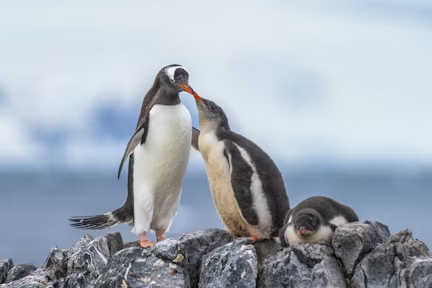
Gentoo penguin and chick
The Antarctic Peninsula is quite simply one of the world’s greatest whale-watching destinations.
Humpback whales are the most common whale you can see around the Antarctic Peninsula, along with the much smaller minke whale and the orca (killer whale). All these species can be found close to the shore or ice; in open water there’s also the chance to see fin whales, the second largest species in the world. Blue whales can sometimes also be seen at sea, but remain very rare.
Whale watching starts slowly in Antarctica: in the early season (Nov–Dec), whales are still migrating south to their feeding grounds. From Christmas onwards, whales appear in greater abundance, with encounters peaking in February and March.
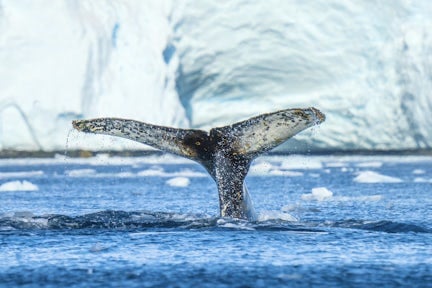
Humpback whale
The most common seal seen around the Antarctic Peninsula is the Weddell seal, encountered happily hauled out on the shoreline or an ice floe. Leopard seals, one of Antarctica's apex predators, are typically found wherever there are penguin rookeries. Crabeater seals, the most populous seal in Antarctica, tend to be encountered more the further south you head: they are great lovers of the pack ice.
At the northern end of the Antarctic Peninsula and around the South Shetland Islands you’ll also find plenty of southern elephant seals and Antarctic fur seals. They actually breed further north in places like South Georgia, but head south to the Peninsula in large numbers to feed as the season progresses.
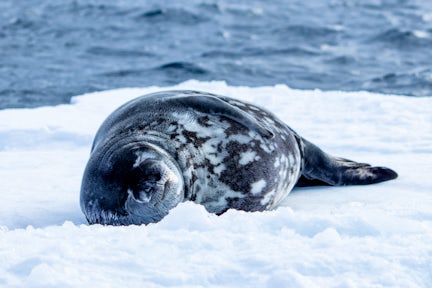
A sleepy Weddell seal
Birdwatching in Antarctica extends to more than just penguins, with many resident or visiting species.
Petrels are the most commonly seen birds. Cape petrels and storm petrels, both of whom follow expedition cruise ships at sea, breed here, along with the beautiful pure white snowy petrel. They breed on cliffs, as do imperial shags (also known as blue-eyed cormorants) southern fulmars and kelp gulls.
Wherever there are penguin rookeries, you’ll find predatory brown skuas, who are also quick to divebomb any visitor accidentally straying too close to their nests. Also associated with penguin rookeries is the pigeon-like snowy sheathbill. These scavengers show a high degree of curiosity around people, often landing on ships or zodiacs, or pecking at any unusual item they encounter.
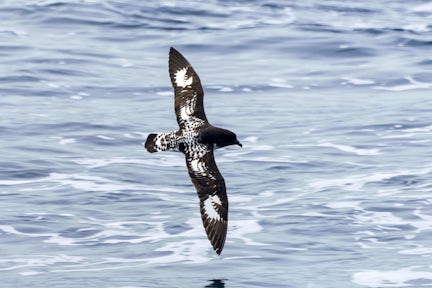
Cape petrel
Most visitors rush straight into the action when they arrive at a penguin rookery, but there's a lot to be said for lingering by the shore, watching individual penguins as they come and go from the water, or porpoising in groups as they return from their feeding grounds.
Price Match Promise - We’ll match any price you find elsewhere for the same trip
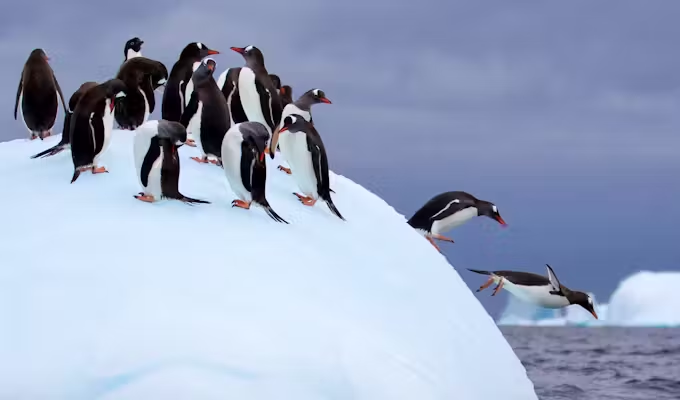
4.8 out of 5
The great strength of this trip is choice – a wide selection of departure dates and optional adventure activities available on a sleek purpose-built 138 passenger expedition ship. Spend four full days exploring Antarctica. Enjoy daily shore landings and zodiac…

4.7 out of 5
Travelling on board this extremely comfortable ship, explore the highlights of the peninsula with a top class expedition team. Spacious cabins, delicious cuisine and optional adventure activities all help create this ideal marriage of comfort and…
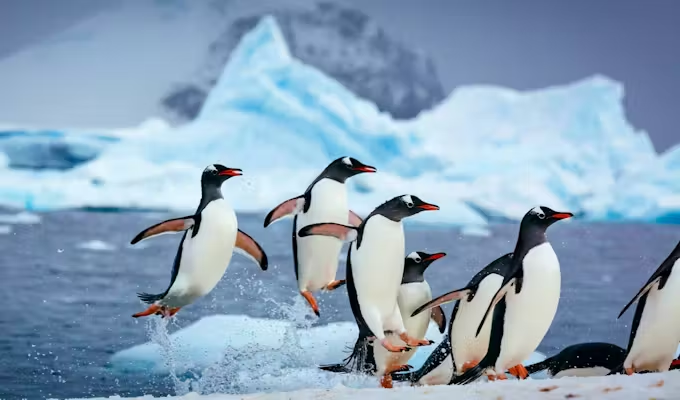
4.4 out of 5
For adventurers prioritising real comfort and ease of travel, this is a great option. Journey in style aboard a state-of-the-art expedition ship, with heli-sightseeing available on select departures for a unique bird's-eye view of Antarctica. Plus, the comprehensive transfer package…
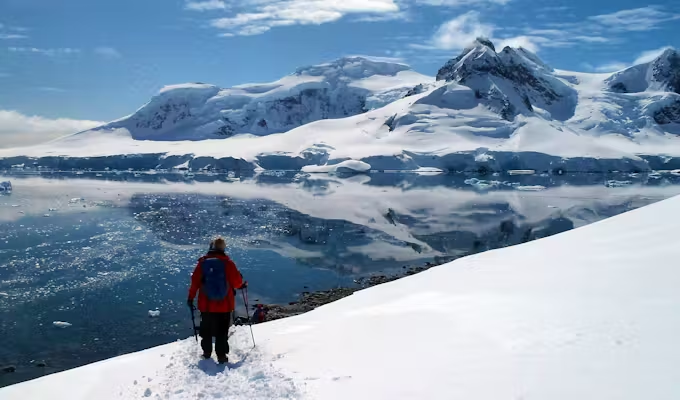
4.5 out of 5
The ultimate polar adventure, this trip is ideal for active travellers who want to experience Antarctica from every angle. Spend an extensive 7 days exploring the White Continent and try kayaking, hiking, camping, mountaineering and snowshoeing, all included in the price.…
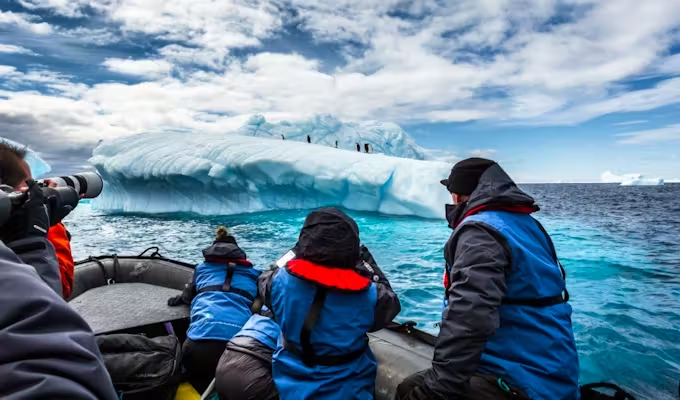
4.3 out of 5
A rare and popular voyage which flies to Antarctica in just two hours, then sails back across the Drake Passage, maximising both expediency and experience. Spend 7 days exploring Antarctica on a small, purpose-built expedition ship, with kayaking and snorkelling…
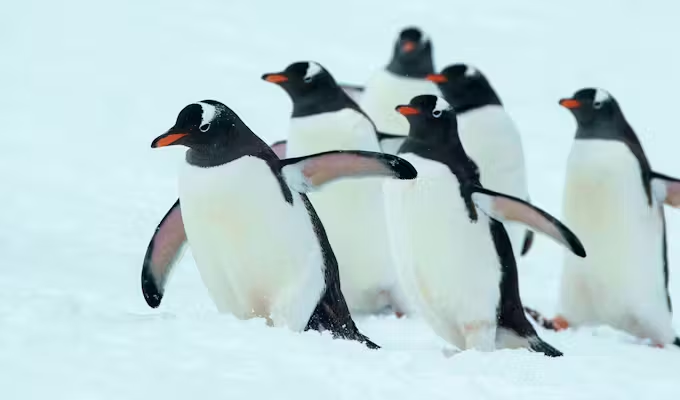
4.7 out of 5
Fly over the Drake Passage in just 2 hours, both to and from Antarctica. Ideal for those wanting a high comfort level, but who have limited time or are anxious sailors. An outstanding program, successfully operated for over 20 years,…
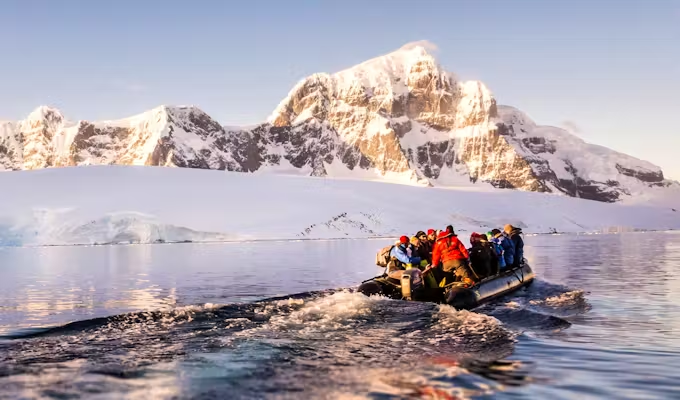
4.8 out of 5
With three medium-sized expedition ships to pick from and regular departure dates throughout the season, this well-priced voyage is a popular option. Across striking landscapes and icy seas, your company includes penguins, seals, whales and skuas. For the adventurous, optional…
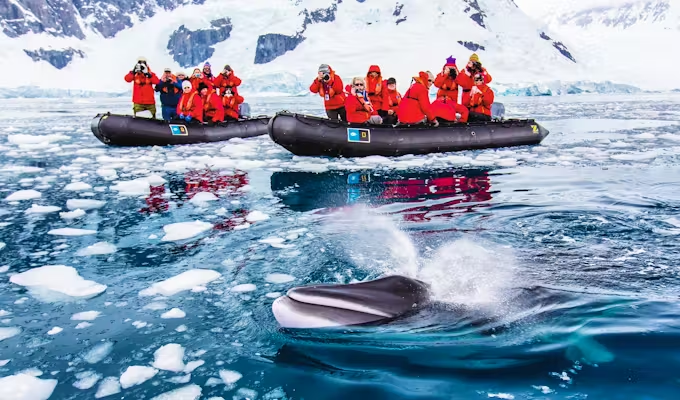
4.7 out of 5
Travelling aboard a state-of-the-art small ship and accompanied by unparalleled onboard expertise, expeditionary cruising doesn’t get much better. Regular departures throughout the season and a choice of two outstanding vessels renowned for their comfort, enhanced safety features and spirit of…
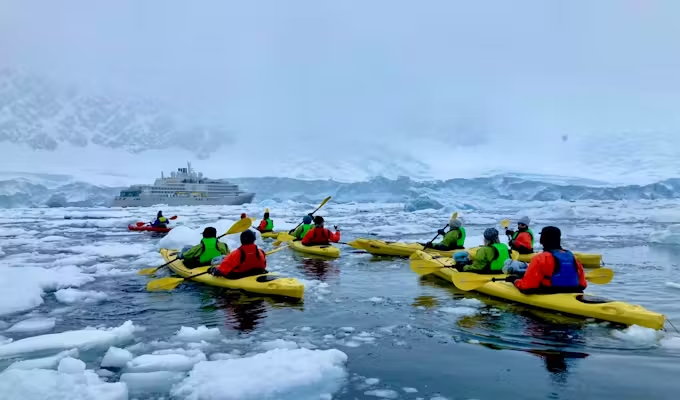
4.7 out of 5
For guests seeking seamless travel on a hassle-free, all-inclusive trip, this is the perfect option. Skip over the notorious Drake Passage on a comfortable two hour flight to Antarctica, then travel on board a state-of-the-art mega yacht, which offers uncompromising…
Most memorable moment? Seeing a leopard seal catch and flay a penguin reminded me that nature is not cuddly. Read the full review
Travelled: March 2025
Sharon Smith - USA
Antarctica was more beautiful than I had expected, and seeing all of the unique wildlife was incredible. Read the full review
Travelled: February 2025
Cooper McBride - USA
The majority of the trip was a memorable moment, but the giant, steaming pile of male elephant seals was incredible! Got some great video of them "talking" to each other. Also got some great video of a close-up humpback whale slapping his fins back and forth.
Travelled: February 2025
Leigh Renkar - USA
There were so many memorable moments, and lots of emotions being there getting to experience it all, finally. One highlight was our first landing, the weather was good and we got to see our first penguins. Read the full review
Travelled: January 2025
Caitlyn Margaret Madden - Ireland
Each day seemed to build upon the previous one. Encountering such a wide variety of wildlife and being fortunate to have such great weather made it super. Read the full review
Travelled: January 2025
Fred Robert Armstrong - USA
Most memorable moment? A 20 minute zodiac segment where we saw a leopard seal, blue eyed shags, Weddell seal, gentoo penguins and a close encounter with a humpback whale. Read the full review
Travelled: January 2025
Kirk Taylor - USA
Amazing experience to be on the water so close to nature, icebergs, whales, penguins and seals in such a serene and magical setting. The sounds were incredible. Read the full review
Travelled: January 2025
Caryn Lombardi - USA
GO! The experience and beauty and wildlife are beyond compare. Our only trip that came close was a self drive through, and camping in, the Serengeti. Read the full review
Travelled: January 2025
Mark Orgren - USA
There were so many memorable moments in Antarctica, from the otherworldly sea, glacier, iceberg landscapes to the birds, mammals, and invertebrates—like jellyfish!—to the people—like the expedition team who shared warmth and fascinating information and the other guests who became our friends. Antarctica was definitely an adventure of a lifetime. Read the full review
Travelled: January 2025
Randy Williams - USA
10/10 - In a nutshell, we learned about the wildlife of Antarctica. We experienced the unbelievable beauty of the Seventh Continent, including the animals and wonders of the landscape. The expedition combined breathtaking excursions with relaxation on board in very comfortable conditions. Read the full review
Travelled: January 2025
Jerzy Pruski - Poland
Most memorable moment? Seeing the mountains pop out of the fog for the very first time when we finally made landfall - unbelievable. Also seeing the penguins, seals, orcas, and WHALES - especially the whale tails! Read the full review
Travelled: December 2024
Sarah Walko - USA
Most memorable moment? Antarctica's scenery and wildlife. It was just amazing. Pristine, untouched and overwhelmingly scenic. You can clearly see the million of years nature's carving of the mountains and the surroundings, making it a wonderland. Read the full review
Travelled: November 2024
Ramesh Penmetcha - USA
Nearly every day’s outing was a memorable moment… though more accurate, a memorable outing! Seeing flying albatross for the first time brought tears to my eyes as I’ve wanted to see them since 2002! Read the full review
Travelled: November 2024
Wanda Niemi - USA
We had Adelie penguins porpoising and playing around our zodiacs, and groups of humpbacks surrounding the zodiacs, surfacing, feeding and fluking literally in front of us. Read the full review
Travelled: March 2024
Hui Hua Chua - USA
Most memorable moment? Seeing a leopard seal chasing a penguin while zodiac exploring. Read the full review
Travelled: March 2024
Gabriel Eduardo Cortez Chávez - Chile
Very hard to pick one most memorable moment, but maybe the hike on Petermann island, surrounded by so many penguins Read the full review
Travelled: February 2024
David DeMaria - USA
I left there more knowledgeable about seals, penguins, whales, clouds, and krill!! The lectures were a great way to make you think about what is in the oceans, where you live, and everywhere. Read the full review
Travelled: February 2024
Debra Sharkey - USA
There was not just one memorable moment. It is all absolutely incredible. Seeing all the penguins, seals and whales. The icebergs, especially in Wilhelmina Bay made me feel like I was in the movie Avatar: The Way of Water. It was all totally amazing! Read the full review
Travelled: February 2024
Carol Forrest - USA
Most memorable moment? Sharing half an hour with two humpback whales circling our zodiac, incredible experience! Read the full review
Travelled: February 2024
Christopher John Oakley - UK
Most memorable moment? Seeing the penguins, whales, seals, dolphins, seabirds in their environment. Natural beauty of Antarctica - the ice, snow, mountains. Learning more from the lectures from the marine biologist. Read the full review
Travelled: February 2024
Michelle Deeton - Canada
Most memorable moment? The otherworldly scenery of Antarctica. Plus the penguins, seals, and chance to mountaineer, kayak and sleep on the continent. Read the full review
Travelled: February 2024
Monica Palme - USA
Most memorable moment? The first time I landed on Antarctica and saw penguins waddling along all around me. Read the full review
Travelled: February 2024
Patricia Gleadle - Australia
We saw something memorable on every excursion, but the most memorable one was when, during a single excursion, we saw three different kinds of seals, penguins on icebergs and humpback whales. Read the full review
Travelled: February 2024
Shirley Sutton - USA
Too many memorable moments to choose from! Humpback whales, penguins, leopard seals, and the polar plunge are highlights, but the landscape itself was magnificent. Waking up every day to new natural marvels was magical. Read the full review
Travelled: February 2024
Jennifer Webb - Canada
Kayaking while 2 inquisitive humpback whales surfaced right next to us. Or seeing an elephant seal snatching 2 young penguins. Actually, there were a lot of memorable moments! Read the full review
Travelled: February 2024
Roy McKenzie - Hong Kong
Most memorable moment? Cruising on the zodiacs through icebergs and glaciers, seeing wildlife right in front of us Read the full review
Travelled: February 2024
Shari Rosenberg - USA
Most memorable moment? Watching the pod of 18-20 orcas from our ship for about 45 minutes as we changed course to stay near them. Read the full review
Travelled: February 2024
Ali Begeja - USA
Most memorable moment? Seeing a bright, sunny clear day on the Antarctic Peninsula full of penguins, seals, and humpback whales with the high plateau in the distance and sculpted icebergs floating by along with my family. Read the full review
Travelled: January 2024
Rebecca Archer-Knepper - USA
Kayaking was the best part of our trip. David was an incredible kayak guide and brought us to really cool spots to paddle around all while ensuring our safety. We got to experience paddling next to whales, seals, and penguins! Read the full review
Travelled: January 2024
Elyse Doherty - USA
My most memorable moments were experiencing wildlife that has absolutely no fear of humans. Penguins will walk right up to you! For their protection, you have to stay 5 meters away from all wildlife on land, including nests. However, if you're standing where a penguin wants to go, it has no qualms about waddling right past you! Seals will sleep on ice floes right next to zodiacs, whales will approach kayakers, and skuas and albatrosses will fly so close to you that you could almost touch them. Read the full review
Travelled: January 2024
Lauren Pecarich - USA
I loved the zodiac cruises! They gave us a chance to see all the wildlife, AND ESPECIALLY THE WHALES, from a whole new point of view. Wow, the whale watching on the cruises was just the best. Love. Read the full review
Travelled: January 2024
Amy Ergle - USA
Most memorable moment? Being on the ice with the penguins. The sound of ice cracking and penguins jumping on water. Read the full review
Travelled: December 2023
Sumathi Krishnan - Malaysia
Just being able to witness the exotic wildlife in Antarctica and animals in their natural habitat was truly magical. The landings were particularly fun as we were able to observe the animals at close proximity. Not to mention meeting friends and some of the friendliest crew members was the cherry on top of the trip. Read the full review
Travelled: December 2023
Rui Qi Peng - Malaysia
Watching the gentoo penguins fighting and squabbling with its neighbors over pebbles to build its nest and how mummy/papa penguins change shifts to keep their eggs warm. And for those which had chicks, it's remarkable watching them feed their young after an outing at the sea. Read the full review
Travelled: December 2023
Seng Muah Mah - Malaysia
I was impressed by the concerns of safety for passengers and the conservation of nature and the environment expressed and practiced by the guides during the journey. Read the full review
Travelled: December 2023
Seng Muah Mah - Malaysia
Most memorable moment? Standing on a ridge on the Antarctic Peninsula with the sun shining down. Standing next to a penguin colony with no civilization close. The water smooth with ice floating. Read the full review
Travelled: December 2023
Michelle Anderson - USA
I'm back from Antarctica and holy cow, IT WAS UNBELIEVABLE! Thank you so much for all your help in planning the trip.
Travelled: February 2017
Renee - Seattle
Review:
The northern Antarctic Peninsula has the highest concentration of wildlife sites in the region as well as the most spectacular scenery.
Gentoo penguins are in particular abundance here. Their largest rookery is on Cuverville Island, with other breeding sites in places like Danco Island, Neko Harbour, and Paradise Bay. The latter is also notable for its chinstrap penguin rookery. South of the Lemaire Channel, Petermann Island is a rarity for having gentoos, chinstraps and Adelies all nesting together.
Leopard seals and Weddell seals are common throughout the northern Peninsula.
The Gerlache Strait and the bays that come off it are all notable hotspots for whale watching: humpbacks, minke whales and orcas are all found here.
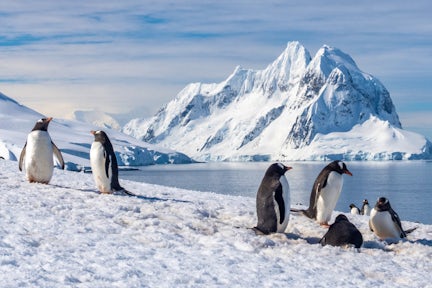
Gentoo penguins on Petermann Island
Penguins form large rookeries in the South Shetland Islands. King George Island, where fly & sail cruises start, is home to all three Peninsula species: gentoo, Adelie and chinstrap penguins. The latter are the most populous species in the islands, with sizeable rookeries also found on Deception Island, as well as Half Moon Island (alongside gentoo rookeries).
Weddell seals and leopard seals are both found in the South Shetlands, plus the occasional crabeater. The islands are the best place to see southern elephant seals and Antarctic fur seals.
The Bransfield Strait, between the South Shetlands and the mainland Peninsula, is excellent for whale-watching, with the possibility of humpbacks and minke whales. The Scotia Sea between the South Shetlands and Elephant Island is known for fin whales.
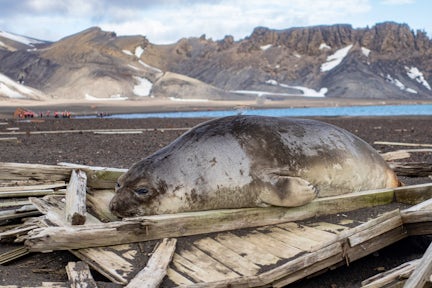
Juvenile elephant seal on Deception Island
Wildlife watching begins the moment you sail south from Ushuaia on an Antarctic expedition cruise. The Drake Passage offers terrific birdwatching, particularly for the albatrosses who will follow your ship.
The most commonly seen species is the black-browed albatross, though you’ll want to keep an eye out for the vast wingspan of the wandering albatross and royal albatross and the smaller light-mantled albatross. A host of other birds will also accompany you, including a wide variety of large and small petrels, dainty prions, plus fulmars and shearwaters.
If the seas are calm, there is always the chance of seeing whales. Fin whales and humpback whales are the most commonly seen, but look out also for hourglass dolphins and long-finned pilot whales.
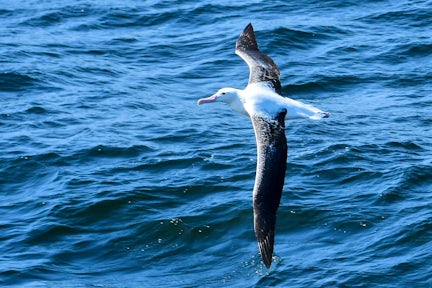
Wandering albatross on the Drake Passage
The further south you sail along the Antarctic Peninsula, the more the wildlife begins to thin out. This is a more of a place to be enjoyed for its raw emptiness; the large penguin rookeries disappear and the only penguin species you’ll see are Adelie penguins in small isolated groups.
Snowy petrels and Antarctic petrels may still be seen close to cliffs, while on the ice you may spot the occasional crabeater seals, which are dependent on sea ice for their lifestyle. They are krill eaters and have their prey largely to themselves: whales tend not to venture this far south along the Peninsula.
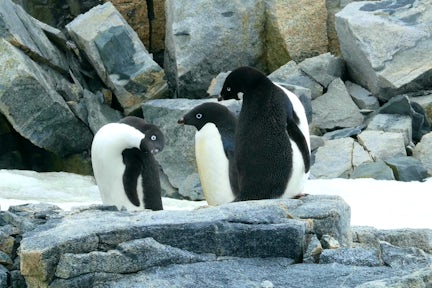
Adelie penguins on Stonington Island
According to the season and the weather, some expedition cruise ships may opportunistically sail through the Antarctic Sound to the northeast Antarctic Peninsula. Locations here such as Brown Bluff and Paulet Island are home to large Adelie penguin rookeries. Gentoo penguins are rare here and chinstraps are completely absent.
The Weddell Sea however does give the best chance to see Antarctica’s most iconic species: the emperor penguin. Wandering individuals can sometimes be seen on the ice, but Snow Hill Island is home to their northernmost rookery, and the only one in the world readily accessible by expedition cruise ship: a small number of ships call here every year.
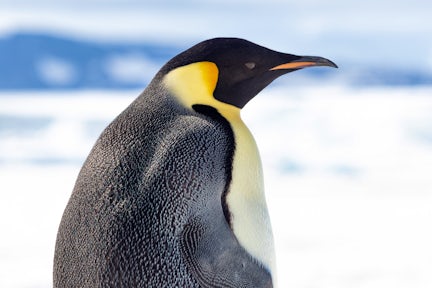
Emperor penguin on the Weddell Sea
Strict wildlife watching guidelines are in place in Antarctica, drawn up by the International Association of Antarctica Tour Operators (IAATO) to avoid any possible harmful impacts on wildlife populations during a visit. Swoop is proud to be an associate member of IAATO and we encourage all our guests to familiarise themselves with their guidelines before travelling.
Your guides will instruct you how to behave when you’re out in the field: always follow their instructions. You must keep safe distance of at least of 15 feet (5m) between you and any animal at all times. If an animal approaches, you must quietly withdraw. Always give wildlife the right of way: don’t walk on the natural highways used by penguins and never get between an animal and the sea.
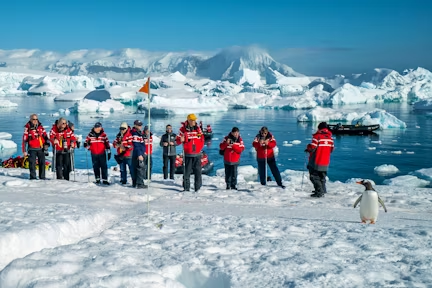
Watching penguins from a safe distance in Antarctica
Antarctica's wildlife experience changes throughout the season so there's no 'best' time to visit as you'll enjoy amazing encounters whenever you travel.
Travelling early in the season offers busy penguin colonies displaying breeding behaviour, high season brings penguin chicks, while late season is the peak time for whale encounters.
For a month-by-month guide to what the wildlife will be doing during your visit, see our page about when to visit Antarctica.
Very close!
Antarctica's wildlife has no fear of people so the challenge isn't getting close to wildlife, it's giving them enough space. It's not uncommon to find yourself being approached by a curious penguin or a fur seal pup full of false bravado.
To avoid disturbing the wildlife and to maintain important biosecurity rules, you must keep a distance of 15 feet (5m) from wildlife at all times, and 33 feet (10m) from the edge of penguin colonies. If an animal approaches you, slowly move away. Wildlife in Antarctica always has the right of way and if anything you do causes an animal to change their behaviour, you're too close and should quietly move away.
Yes.
On board you'll find a variety of guides with a wealth of wildlife experience to tell you more about the animals you're seeing – both while you're on shore and during dedicated talks on the ship. Expert guides are an integral part of the expedition cruise experience, so don't be surprised if your guides have a background in scientific research in the region as well as working with tourists.
Visitors to Antarctica in the early season will see lots of breeding and nesting behaviour among penguins, but the chicks don't typically hatch until the very end of December (in time for Christmas) and throughout January.
From this time you'll see lots of chicks, growing fatter and becoming more curious about their environment until the end of the tourist season in March when they're getting ready to fledge in time for winter.
You can see whales at any time through the Antarctic season, but the numbers of sightings typically increase as the season progresses.
At the start of the season in November many whales are migrating south from the tropics to their polar feeding grounds. In the new year, and especially in February and March, they'll have spent a summer happily gorging on krill and will often approach zodiacs out of curiosity now their hunger has been sated.

Whether you’re visiting the Antarctic Peninsula or heading for the South Pole, discover the different routes by sea and air to visit the Seventh Continent.
Discover More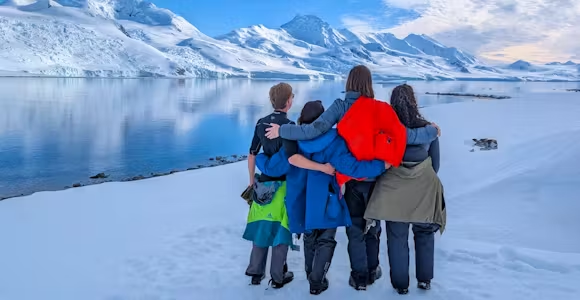
Choosing when to go to Antarctica is a key part of planning a cruise, with each month of the season offering a different side of the continent.
Discover More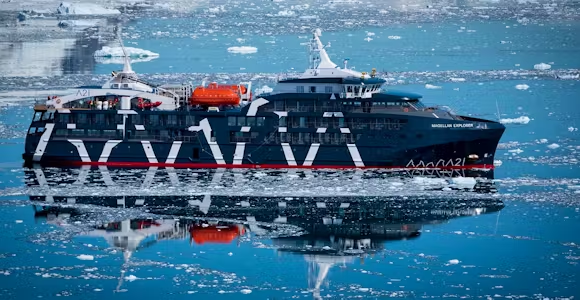
We work with a range of different Antarctic vessels, with expertise across the entire polar fleet, to give you the best choice of ship, cabin and departure date.
Discover More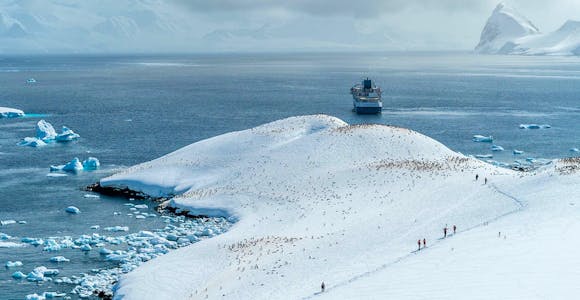
Whether you’re visiting penguin rookeries, zodiac cruising through iceberg graveyards or looking for whales, there’s no shortage of places to see on the Antarctic Peninsula.
Discover MoreWe'll spend some time listening to your aspirations, then discuss the kind of experience that might suit you.
Next we'll discuss the options, shortlist the best trips for you and present you our impartial recommendations.
We'll place a 24 hour hold on your preferred option - without obligation - whilst we talk through the details.
With over 100 years of Antarctic experience between us, we can help guide you to exactly the right trip for you.
1 888 970 4570This website uses cookies to ensure you get the best experience on our website. Privacy policy
We don’t charge a commission and there are no hidden fees. Just impartial, expert advice from the leading Polar cruise agent. Schedule a call with our Antarctic Experts today.